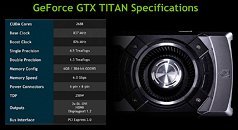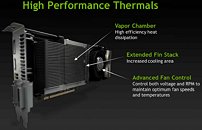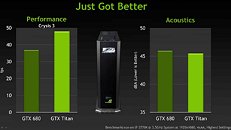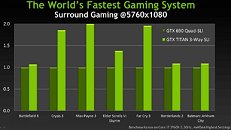Tuesday, February 19th 2013

NVIDIA GeForce GTX Titan Final Specifications, Internal Benchmarks Revealed
Specifications of NVIDIA's upcoming high-end graphics card, the GeForce GTX Titan, which were reported in the press over the last couple of weeks, are bang on target, according to a specs sheet leaked by 3DCenter.org, which is allegedly part of the card's press-deck. According to the specs sheet, the GTX Titan indeed features 2,688 out of the 2,880 CUDA cores present on the GK110 silicon, 6 GB of GDDR5 memory across a 384-bit wide memory interface, and draws power from a combination of 6-pin and 8-pin PCIe power connectors.
The GeForce GTX Titan core is clocked at 837 MHz, with a GPU Boost frequency of 876 MHz, and 6.00 GHz memory, churning out 288 GB/s of memory bandwidth. The chip features a single-precision floating-point performance figure of 4.5 TFLOP/s, and 1.3 TFLOP/s double-precision. Despite its hefty specs that include a 7.1 billion-transistor ASIC and 24 GDDR5 memory chips, NVIDIA rates the card's TDP at just 250W.More slides and benchmark figures follow.
The next slide leaked by the source reveals key features of the reference design cooling solution, which uses a large lateral blower that features RPM and voltage-based speed control on the software side, a vapor-chamber plate that draws heat from the GPU, memory, and VRM; and an extended aluminum fin stack that increases surface area of dissipation.Next up, we have performance numbers by NVIDIA. In the first slide, we see the GTX Titan pitted against the GTX 680, in Crysis 3. The GTX Titan is shown to deliver about 29 percent higher frame-rates, while being a tiny bit quieter than the GTX 680.
In the second slide, we see three GeForce GTX Titans (3-way SLI) pitted against a pair of GeForce GTX 690 dual-GPU cards (quad-SLI). In every test, the Titan trio is shown to be faster than GTX 690 Quad-SLI. In Crysis 3, GTX Titan 3-way SLI is shown to be about 75 percent faster; 100 percent faster in Max Payne 3, 40 percent faster in TESV: Skyrim, and 95 percent faster in Far Cry 3. Why this comparison matters for NVIDIA is that if Titan does end up being a $1000 product, NVIDIA will have to sell three of them while offering something significantly better than GTX 690 quad-SLI.
Source:
3DCenter.org
The GeForce GTX Titan core is clocked at 837 MHz, with a GPU Boost frequency of 876 MHz, and 6.00 GHz memory, churning out 288 GB/s of memory bandwidth. The chip features a single-precision floating-point performance figure of 4.5 TFLOP/s, and 1.3 TFLOP/s double-precision. Despite its hefty specs that include a 7.1 billion-transistor ASIC and 24 GDDR5 memory chips, NVIDIA rates the card's TDP at just 250W.More slides and benchmark figures follow.
The next slide leaked by the source reveals key features of the reference design cooling solution, which uses a large lateral blower that features RPM and voltage-based speed control on the software side, a vapor-chamber plate that draws heat from the GPU, memory, and VRM; and an extended aluminum fin stack that increases surface area of dissipation.Next up, we have performance numbers by NVIDIA. In the first slide, we see the GTX Titan pitted against the GTX 680, in Crysis 3. The GTX Titan is shown to deliver about 29 percent higher frame-rates, while being a tiny bit quieter than the GTX 680.
In the second slide, we see three GeForce GTX Titans (3-way SLI) pitted against a pair of GeForce GTX 690 dual-GPU cards (quad-SLI). In every test, the Titan trio is shown to be faster than GTX 690 Quad-SLI. In Crysis 3, GTX Titan 3-way SLI is shown to be about 75 percent faster; 100 percent faster in Max Payne 3, 40 percent faster in TESV: Skyrim, and 95 percent faster in Far Cry 3. Why this comparison matters for NVIDIA is that if Titan does end up being a $1000 product, NVIDIA will have to sell three of them while offering something significantly better than GTX 690 quad-SLI.




132 Comments on NVIDIA GeForce GTX Titan Final Specifications, Internal Benchmarks Revealed
I have to admit, I'm also not really a dual-card/SLI/Xfire fan, but I still find it fascinating and promising that - with such power consumption - there is a possibility of a dual GK110 card in the near future (to hold the candle until next generation arrives).
Events like these will probably also force AMD to move soon, which can lead to a - much needed - price war perhaps :toast:
ThusMakes it look that from the price point of view, x2 7970 would still be much better deal.
Of course, that is only from this one point of view. I could name many situations where the Titan would be the sanest choice. But w/e.
P.S. please note that for various reasons, I simply cannot use AMD cards, even if I wanted. As an example.
Source + more juicy info:
videocardz.com/39721/nvidia-geforce-gtx-titan-released
Why spend that much for the Titan when you can wait a few months for the GTX 780 which will likely match the performance at a saner price?
Or maybe it's like one "freak" card that is "disowned by the family", thus being in its own "group" that includes only itself and nothing else?
i.e. the model name "Titan" makes its position rather ambiguous.
www.guru3d.com/articles_pages/geforce_gtx_titan_preview_reference,1.html
It's a limited edition card that will sell because it's limited edition.
AMD would do the same if they were smart, release a monster single GPU card and have it limited to 1000 or so units. They would make money off the people who need the absolute best, no matter the cost.
Kinda like the old guy in Jurassic Park. "Spare no expense"
$1000.
800 euros.
Arseholes. :mad:
I'm guessing around GTX660Ti SLI performance this card will be :cool:
"Aaaaand STOP
And that's where this article ends, sorry! Now we'll share the manufacturer suggested retail prices.
EUR 800 Ex VAT
GBP 827 Inc. VAT
USD 999 Inc. VAT"
www.geforce.com/hardware/desktop-gpus/geforce-gtx-titan/performance